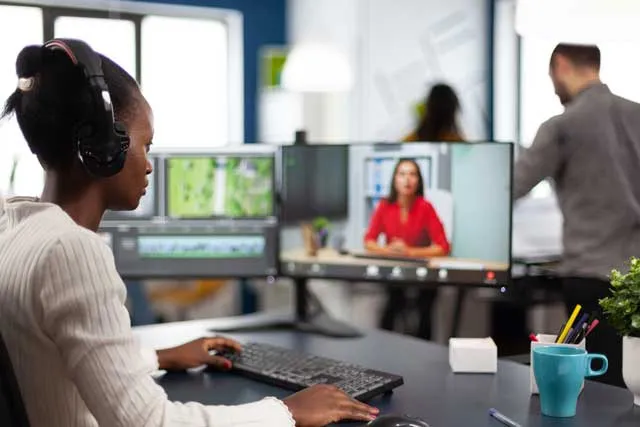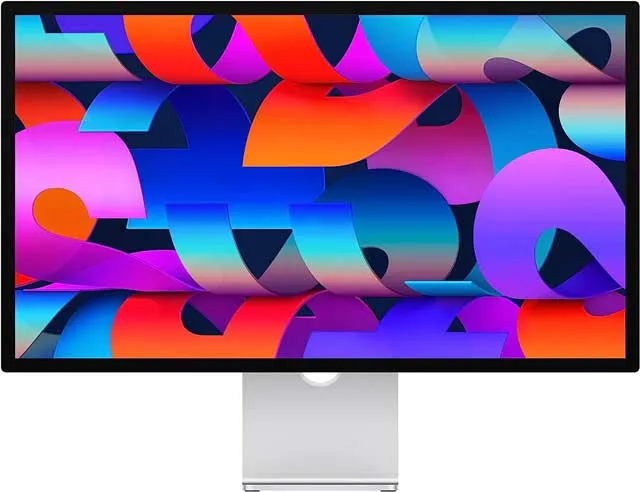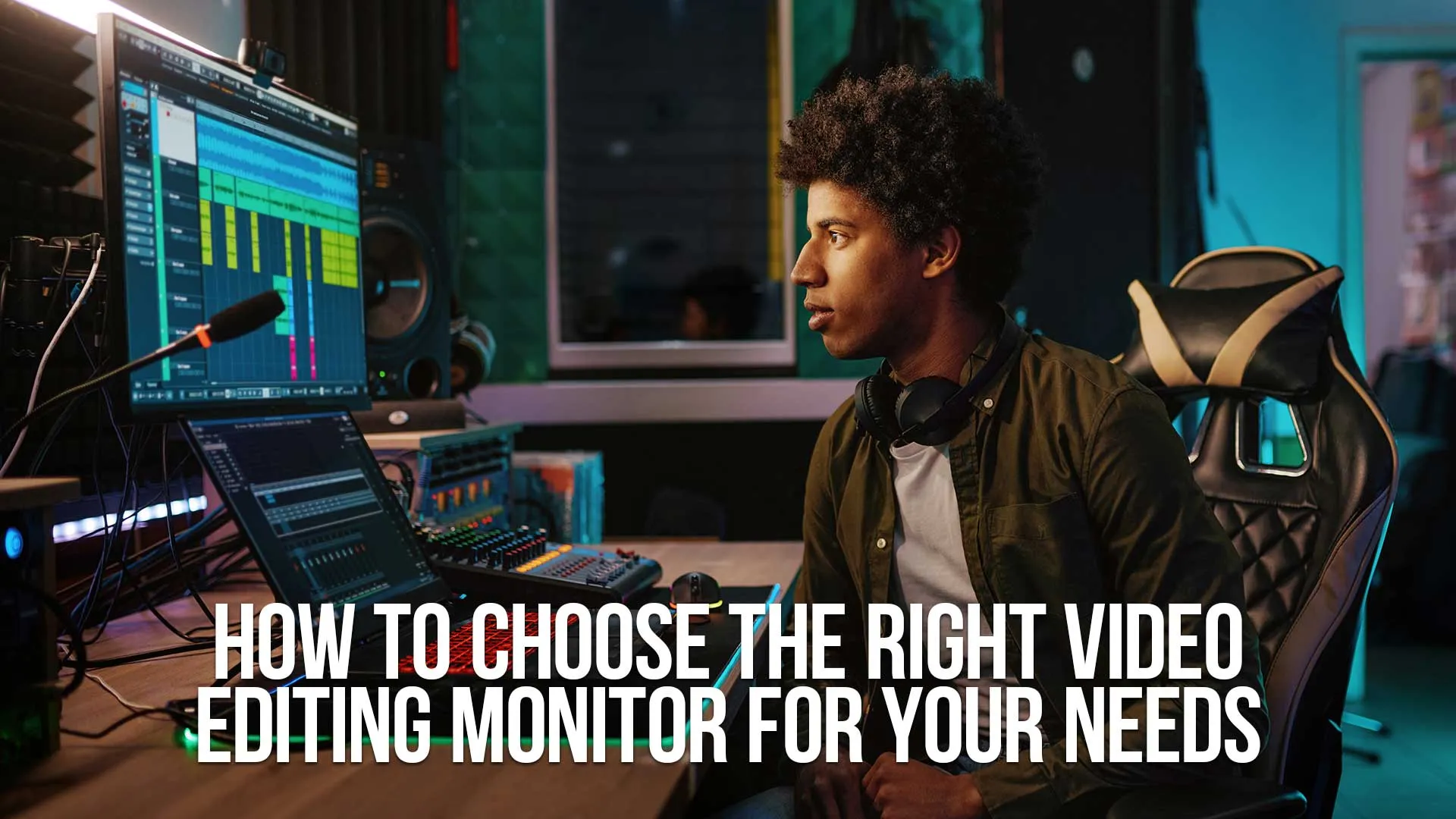Parent Article: The Best Monitors for Video Editing
If you are a video editor, choosing the right monitor is crucial to ensure you can achieve the best results possible.
A high-quality video editing monitor is not just about having a clear and crisp display but also color accuracy, resolution, and many other features that can enhance your work.
In this article, we will guide you on how to choose the right video editing monitor for your needs.
We will cover various factors that you should consider before making a purchase, including screen size, resolution, color accuracy, refresh rate, panel type, and more.

Screen Size and Resolution
The size of your monitor will depend on your workspace and personal preference.
However, when it comes to video editing, bigger is usually better.
A larger screen will provide more space for your timeline and editing tools, making it easier to work with your footage.
In terms of resolution, a higher resolution monitor will provide sharper and more detailed visuals.
If you plan on working with high-resolution footage, a 4K monitor is highly recommended.
A 1080p monitor may be sufficient for basic editing tasks, but it may not provide the level of detail needed for professional work.
Color Accuracy
Color accuracy is essential when it comes to video editing. If your monitor cannot display accurate colors, your final product may look different on other screens.
When choosing a monitor for video editing, look for one with a high color gamut and color depth.
A color gamut is the range of colors that a monitor can display, and a higher color depth means that the monitor can display more shades of each color.
Look for a monitor that covers at least 100% of the sRGB color gamut and has a color depth of 10-bit or higher.

Video Monitor Connectivity Options
HDMI (High-Definition Multimedia Interface):
A widely used interface for transmitting audio and video data. Ideal for connecting to most consumer electronics. Supports various formats, including 4K and HDR.
DisplayPort:
Primarily used in computer monitors. Supports higher refresh rates and resolutions compared to HDMI. Capable of daisy-chaining multiple monitors from a single output.
USB-C:
A modern, versatile interface. Supports data transfer, video/audio output, and power delivery. Convenient for connecting laptops directly to monitors.
Thunderbolt 3/4:
Offers high bandwidth, combining data, video, and power. Ideal for high-resolution displays and data-intensive tasks. Compatible with USB-C, enhancing its versatility.
DVI (Digital Visual Interface):
Older interface, mainly found in legacy systems. Supports high-definition video but lacks audio transmission. Becoming less common in modern monitors.
Video Monitor Emerging Technologies
OLED (Organic Light-Emitting Diode):
Delivers high contrast ratios and true blacks. Offers better viewing angles and faster response times. More expensive and has concerns about screen burn-in.
QLED (Quantum Dot LED):
Employs quantum dots to enhance brightness and color volume. Combines LED backlighting with quantum dot technology. Provides vibrant colors, but contrast ratio is lower than OLED.
MicroLED:
Consists of tiny LEDs, eliminating the need for a backlight. Offers exceptional brightness and energy efficiency. Still in early stages with high production costs.
HDR (High Dynamic Range):
Improves color depth and contrast ratios. Delivers more realistic and vibrant images. Requires content specifically mastered for HDR.
8K Resolution:
Offers four times the resolution of 4K. Provides exceptional detail, beneficial for large screens. Limited content availability and requires high processing power.

Refresh Rate
The refresh rate of a monitor refers to how many times per second the image on the screen is refreshed.
A higher refresh rate can reduce motion blur, making it easier to work with fast-moving footage.
For video editing, a refresh rate of at least 60Hz is recommended.
However, if you also plan on using your monitor for gaming, a higher refresh rate may be more suitable.
Panel Type
There are three main types of monitor panels: twisted nematic (TN), in-plane switching (IPS), and vertical alignment (VA).
Each panel type has its advantages and disadvantages, so it's essential to choose the one that best suits your needs.
TN panels are known for their fast response times and low input lag, making them ideal for gaming. However, they have poor color accuracy and viewing angles.
IPS panels have excellent color accuracy and wide viewing angles, making them ideal for video editing. However, they tend to have slower response times and higher input lag than TN panels.
VA panels have high contrast ratios and deep blacks, making them suitable for watching movies and editing dark footage. However, they tend to have slower response times and poor viewing angles.

Additional Features
Other features to consider when choosing a video editing monitor include:
- USB-C connectivity: Allows you to connect your monitor to your laptop and charge it at the same time.
- HDR support: Provides a wider color gamut and higher contrast ratios for more vibrant visuals.
- Adjustable stand: Allows you to adjust the height and angle of your monitor for a more comfortable viewing experience.
- Built-in speakers: May be useful if you don't have external speakers.

Video Editing Monitor Frequently Asked Questions
What is the best monitor size for video editing?
The best monitor size for video editing depends on your workspace and personal preference. However, a larger screen is usually better as it provides more space for your timeline and editing tools.
Is a 4K monitor necessary for video editing?
A 4K monitor is not necessary for video editing. However, a higher resolution monitor will provide sharper and more detailed visuals, which can be helpful for professional work. It's important to choose a resolution that best fits your needs and budget.
What is color gamut?
Color gamut refers to the range of colors that a monitor can display. A wider color gamut means that a monitor can display more colors, which can be important for tasks like video editing where color accuracy is crucial.
What is color depth?
Color depth refers to the number of bits used to represent each color on a monitor. A higher color depth means that a monitor can display more shades of each color, which can result in more accurate and realistic colors.
Is a higher refresh rate better for video editing?
A higher refresh rate can reduce motion blur, making it easier to work with fast-moving footage. However, for video editing, a refresh rate of at least 60Hz is usually sufficient.
Which panel type is best for video editing?
IPS panels are typically considered the best panel type for video editing due to their excellent color accuracy and wide viewing angles. However, TN and VA panels may also be suitable depending on your needs and preferences.
Do I need a monitor with USB-C connectivity for video editing?
USB-C connectivity can be useful for connecting your monitor to your laptop and charging it at the same time. However, it's not necessary for video editing.
What is HDR?
HDR stands for high dynamic range and refers to a feature that provides a wider color gamut and higher contrast ratios for more vibrant and realistic visuals. It can be helpful for video editing, but it's not essential.
Is an adjustable stand necessary for video editing?
An adjustable stand can be helpful for video editing as it allows you to adjust the height and angle of your monitor for a more comfortable viewing experience. However, it's not necessary.
Should I get a monitor with built-in speakers for video editing?
Built-in speakers can be useful if you don't have external speakers, but they're not necessary for video editing. It's generally recommended to use external speakers or headphones for the best audio quality.
How do I calibrate my monitor for video editing?
To calibrate your monitor for video editing, you can use calibration software or a colorimeter to adjust the monitor's color settings. It's important to calibrate your monitor regularly to ensure accurate color representation.
Conclusion
Choosing the right video editing monitor is crucial to ensure that you can produce high-quality work. When choosing a monitor, it's important to consider factors such as screen size, resolution, color accuracy, refresh rate, and panel type. Other features, such as USB-C connectivity, HDR support, adjustable stands, and built-in speakers, can also be helpful but are not essential.
By considering these factors, you can choose a video editing monitor that best suits your needs and budget. Remember to regularly calibrate your monitor to ensure accurate color representation and consider investing in external speakers or headphones for the best audio quality.

About the Author
Joseph Nilo has been working professionally in all aspects of audio and video production for over twenty years. His day-to-day work finds him working as a video editor, 2D and 3D motion graphics designer, voiceover artist and audio engineer, and colorist for corporate projects and feature films.
Video Monitors Related Posts
The Best Monitors Compatible with MacBook Pro
Best Monitors for Video Editing
Understanding Monitor Resolution and Its Impact on Video Editing
Calibrating Your Video Editing Monitor for Optimal Color Accuracy
The Benefits of Dual-Monitor Setups for Video Editing
Future-Proofing Your Video Editing Setup: Choosing a Monitor with Upgrade Potential
Minimizing Eye Strain and Fatigue with the Right Video Editing Monitor
How to Choose the Right Video Editing Monitor for Your Needs
What to Look for in HDR-Capable Video Editing Monitors
The Importance of Color Accuracy in Video Editing Monitors
IPS vs. TN Panels: Which is Better for Video Editing Monitors?
Video Editing Related Posts
Adobe Creative Cloud for Video Editing
Top 10 Video Editing Software for Mac
The Benefits of Dual-Monitor Setups for Video Editing
How to Choose the Right Video Editing Monitor for Your Needs
Best Monitors for Video Editing
Best Video Editing Software in 2023
Best Mac for Video Editing in 2023
(Almost) 50 Mistakes Every New Video Producer Makes
Breakthrough AI Tools: Elevate Your Video Production Game!
- Screen Size And Resolution
- Color Accuracy
- Video Monitor Connectivity Options
- Video Monitor Emerging Technologies
- Refresh Rate
- Panel Type
- Additional Features
Video Monitors Related Posts
The Best Monitors Compatible with MacBook Pro
Best Monitors for Video Editing
Understanding Monitor Resolution and Its Impact on Video Editing
Calibrating Your Video Editing Monitor for Optimal Color Accuracy
The Benefits of Dual-Monitor Setups for Video Editing
Future-Proofing Your Video Editing Setup: Choosing a Monitor with Upgrade Potential
Minimizing Eye Strain and Fatigue with the Right Video Editing Monitor
How to Choose the Right Video Editing Monitor for Your Needs
What to Look for in HDR-Capable Video Editing Monitors
The Importance of Color Accuracy in Video Editing Monitors
IPS vs. TN Panels: Which is Better for Video Editing Monitors?
Video Editing Related Posts
Adobe Creative Cloud for Video Editing
Top 10 Video Editing Software for Mac
The Benefits of Dual-Monitor Setups for Video Editing
How to Choose the Right Video Editing Monitor for Your Needs
Best Monitors for Video Editing
Best Video Editing Software in 2023
Best Mac for Video Editing in 2023
(Almost) 50 Mistakes Every New Video Producer Makes
Breakthrough AI Tools: Elevate Your Video Production Game!
